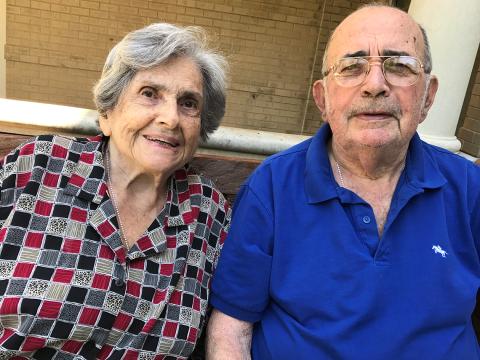Former DRG Director and NIH Scientist Wife Remembered

A remarkable couple who devoted most of their lives to public service and health at NIH recently passed away. At age 91, they both succumbed to Covid-19. Dr. Jerome “Jerry” Green died on Apr. 26 and Dr. Marie Röder Green died on May 10. But Jerry and Marie should be remembered as a scientific power couple.
Jerry retired as director of the Division of Research Grants (now the Center for Scientific Review) in 1995, after 40 years of service at DRG, NHLBI and in the Commissioned Corps. Marie retired as an NHLBI program officer after many years of federal service.
Thousands of scientists across the country still benefit from Jerry’s efforts to advance NIH extramural research programs.
While at DRG, he championed the First Independent Research Support and Transition (FIRST) award, which supports newly independent investigators, and the Method to Extend Research In Time (MERIT) award, which provides long-term support to investigators who demonstrate remarkable ability and productivity.
Marie was a trailblazer at a time when few females worked at the bench. In 1956, she joined an intramural lab at what is now NIAMS. After she and Jerry started their family in California, she returned to the bench at what is now Case Western Reserve University in Cleveland.
Moving back to D.C., she joined the Armed Forces Institute of Pathology in Washington, D.C. Marie eventually returned to NIAMS under a fellowship in its Laboratory of Biochemistry and Metabolism. She later moved to NCI, where she primarily studied breast cancer in its Laboratory of Molecular Carcinogenesis. Marie then joined NHLBI in 1988, after a couple of years away from NIH.
According to their daughter, Karen Green, they encouraged each other in nightly discussions of science and work at the dinner table. Some of those discussions likely focused on Marie’s effort to advance research on carcinogens in cosmetics and to get the FDA to act after she discovered that a stain called Stanzel could detect possible carcinogens in lipstick. Finally, after she published a study in 1980—“Mutagenicity of Some Lipsticks and Their Dyes”—in the Journal of the National Cancer Institute and other researchers weighed in, the FDA banned the use of Orange No. 17 dye in cosmetics 3 years later.
Jerry and Marie’s love affair with each other and science began when they met in freshman biology class at Brooklyn College. After Marie earned a master’s in zoology at the University of Wisconsin, she married Jerry and joined him at Albany Medical School, where he earned his M.D. and she earned her Ph.D. in pathology.
In 1955, Jerry joined what is now NHLBI and the Commissioned Corps, which sent him to the San Francisco PHS Hospital for his residency. While there, he also served as a special research fellow at the Cardiovascular Research Institute at the University of California, San Francisco. He and his family then moved to Ohio, where he was a senior research fellow and clinical investigator at the Cleveland Clinic.
Jerry returned to NHLBI in 1965 to help lead its extramural programs and eventually became its director of extramural affairs. His accomplishments advancing NHLBI’s extramural programs were recognized when NIH named him DRG director in 1986.
When Jerry retired in 1995, he was a rear admiral and assistant surgeon general in the PHS, conferred by Surgeon General C. Everett Koop. He also garnered multiple awards in his career, including the Assistant Secretary for Health’s Award for Exceptional Achievement “for outstanding leadership in effecting changes in NIH extramural program activities.”
Jerry and Marie both came from families that gratefully found homes in the U.S. after fleeing persecution in Europe. As a result, “they were very big social justice people,” said Karen. “They gave to a lot of causes like the Southern Poverty Law Center and the ACLU, and Doctors Without Borders.”
The concern Jerry had for others radiated into his work life. “He raised the bar in DRG,” said Barbara Williams, his former secretary and long-time friend. “He brought a whole new level of respect for everyone who worked there…and he gave me the confidence and tools to succeed when I moved to the NIH Executive Secretariat.”
The admiration he earned also endured. Anne Stroh, a former DRG and NHLBI human resources specialist, explained: “After he retired, several of us routinely had lunch with Dr. Green…This continued in more recent years with visits with him and his wife.” Stroh treasured these conversations, which sparkled with humor and intelligence even in later years.
Condolences and remembrances would be appreciated via jerryandmariegreen@gmail.com.
